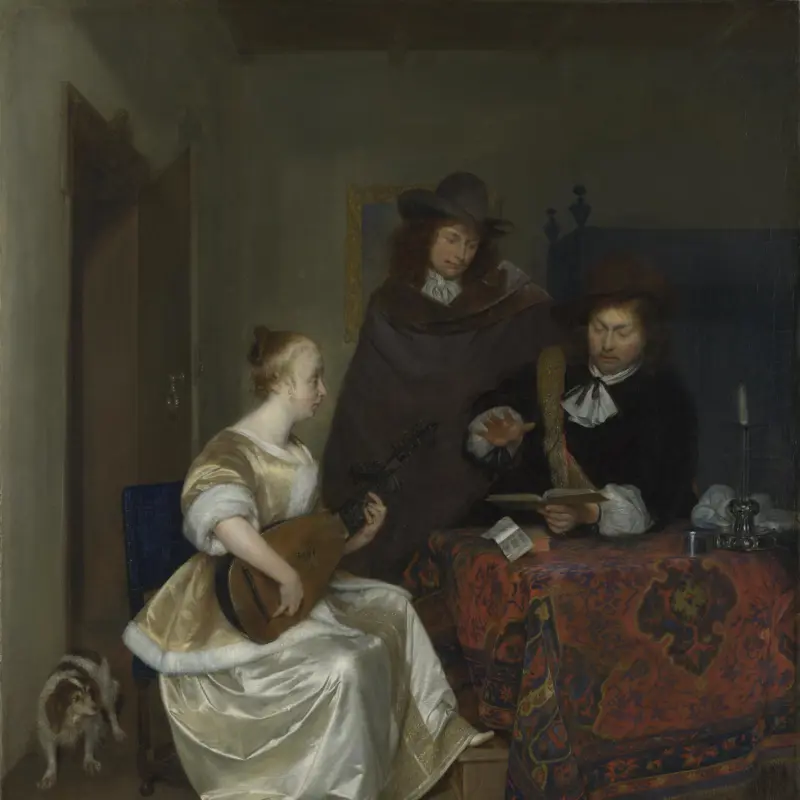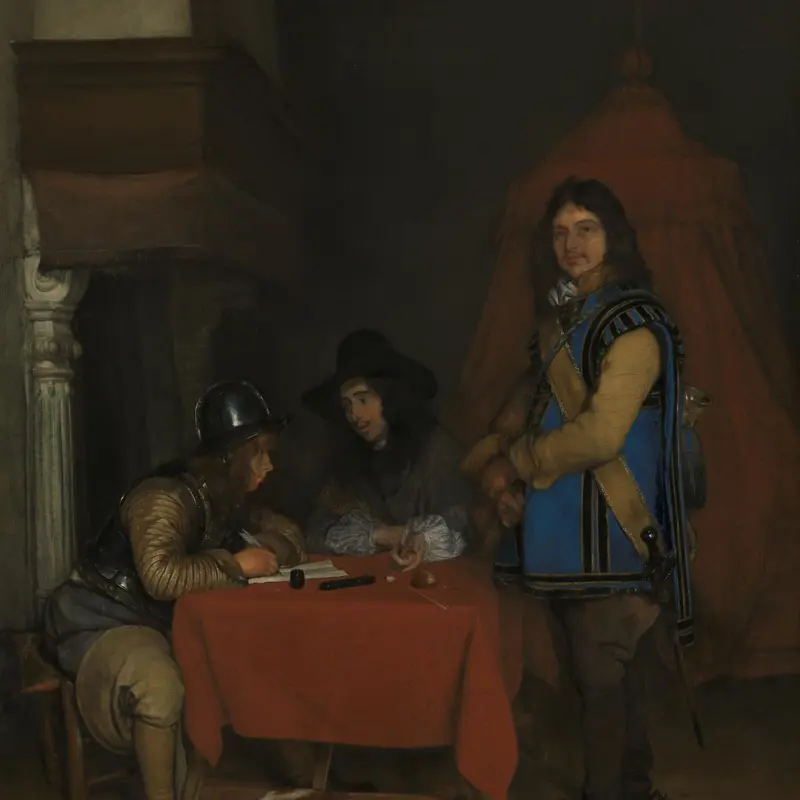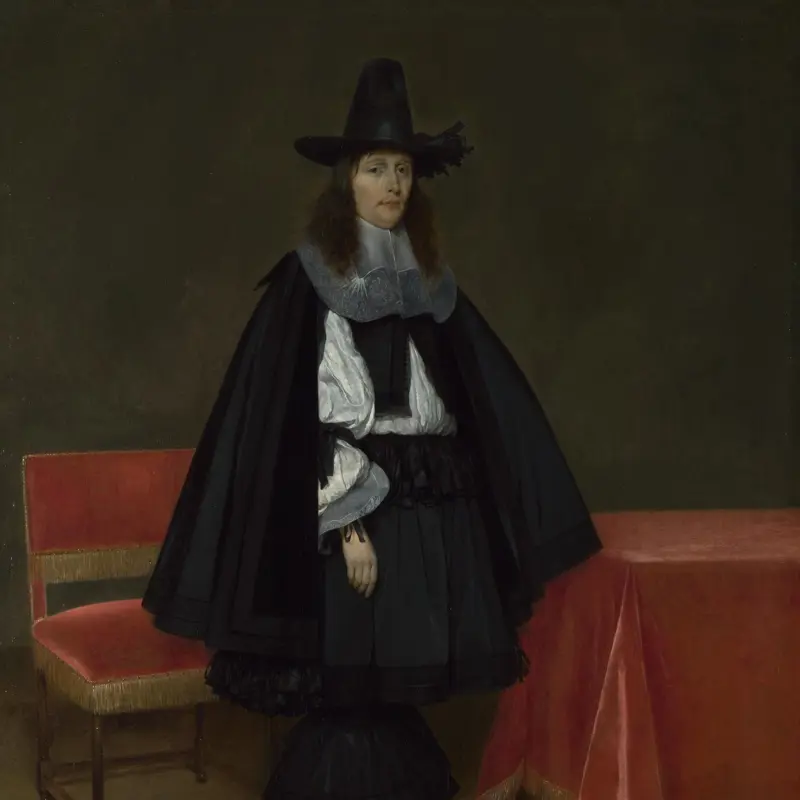Gerard ter Borch, 'The Ratification of the Treaty of Münster', 1648
About the work
Overview
This painting records a key moment in European political history: the confirmation of the treaty which formally granted independence to the Dutch nation from Spanish control in 1648. The key figures are the six Dutch and two Spanish delegates, shown in the centre swearing the treaty oath, and ter Borch’s own self portrait – he’s on the left, with a reddish moustache and long fair hair, looking out at us.
It’s also the first known oil painting to depict such a political event in a ‘factual’ way. Before this date, artists tended to glorify such moments, for example casting the protagonists as classical heroes in a fantasy setting. But although ter Borch has arranged the figures artificially so that the most important are clearly visible, they are depicted with lifelike portraits, and we know, from written accounts by eyewitnesses, that many of the details of the hall and its furnishings are accurately represented.
Key facts
Details
- Full title
- The Swearing of the Oath of Ratification of the Treaty of Münster
- Artist
- Gerard ter Borch
- Artist dates
- 1617 - 1681
- Date made
- 1648
- Medium and support
- oil on copper
- Dimensions
- 45.4 × 58.5 cm
- Inscription summary
- Signed; Dated and inscribed
- Acquisition credit
- Presented by Sir Richard Wallace, 1871
- Inventory number
- NG896
- Location
- On loan: At Home with Ter Borch: A Family of Artists in Zwolle, Museum de Fundatie, Zwolle, Netherlands
- Collection
- Main Collection
Provenance
Additional information
Text extracted from the ‘Provenance’ section of the catalogue entry in Neil MacLaren, revised and expanded by Christopher Brown, ‘National Gallery Catalogues: The Dutch School: 1600–1900’, London 1991; for further information, see the full catalogue entry.
Exhibition history
-
2005Long Loan to the Rijksmuseum (2005 - 2012)Rijksmuseum Amsterdam1 December 2005 - 1 May 2012
-
2012Long Loan to the Rijksmuseum (2012 - 2015)Rijksmuseum Amsterdam2 May 2012 - 3 May 2015
-
2015Long Loan to the Rijksmuseum (May 2015 - March 2017)Rijksmuseum Amsterdam4 May 2015 - 22 March 2018
-
2018Peace. From Antiquity to the Present DayLWL - Museum für Kunst und Kultur28 April 2018 - 2 September 2018
-
2018Long Loan to the Rijksmuseum (2018 - 2023)Rijksmuseum Amsterdam2 May 2018 - 1 February 2023
-
2018The Eighty Years WarRijksmuseum Amsterdam12 October 2018 - 20 January 2019
-
2019Velázquez, Rembrandt, Vermeer. Parallel VisionsMuseo Nacional del Prado25 June 2019 - 29 September 2019
-
2023Long Loan to the Rijksmuseum (2023 - 2026)Rijksmuseum Amsterdam2 February 2023 - 1 February 2026
-
2025At Home with Ter Borch: A Family of Artists in ZwolleMuseum de Fundatie6 September 2025 - 1 February 2026
Bibliography
-
1824W. Buchanan, Memoirs of Painting: With a Chronological History of the Importation of Pictures by the Great Masters into England Since the French Revolution, London 1824
-
1829
J. Smith, A Catalogue Raisonné of the Works of the Most Eminent Dutch, Flemish, and French Painters: In Which is Included a Short Biographical Notice of the Artists, with a Copious Description of Their Principal Pictures […], 9 vols, London 1829-1842
-
1907C. Hofstede de Groot, Catalogue Raisonné of the Works of the Most Eminent Dutch Painters of the Seventeenth Century, 10 vols, London 1907
-
1907C. Hofstede de Groot, Catalogue Raisonné of the Works of the Most Eminent Dutch Painters of the Seventeenth Century, 10 vols, London 1907
-
1948J.H. Scholte, 'Munster in het werk van Gerard ter Borch', Oud Holland, 1948, pp. 9-34
-
1959F. Dickmann, Der Westfälische Frieden, Münster 1959
-
1960Maclaren, Neil, National Gallery Catalogues: The Dutch School, 2 vols, London 1960
-
1973C.J.A. Genders, 'De bevestiging van de vrede van Munster door Gerard ter Borch', Spiegel Historiael, VIII, 1973, pp. 642-50
-
1974A.K. Wheelock et al., Gerard ter Borch (exh. cat. Mauritshuis, 9 March 1974 - 28 April 1974), The Hague 1974
-
1991Maclaren, Neil, revised by Christopher Brown, National Gallery Catalogues: The Dutch School, 1600-1900, 2nd edn (revised and expanded), 2 vols, London 1991
-
1998H.B. Demoed, 'Gerard ter Borch en de Vrede van Munster', Gelders Erfgoed, 1998, pp. 1-5
-
1998K. Bussmann and H. Schilling, 1648: War and Peace in Europe, (exh. cat. Westfälisches Landesmuseum für Kunst und Kulturgeschichte and Kulturhistorisches Museum, 24 October 1998 - 17 January 1999), Münster 1998
-
1998A. Kettering, Gerard ter Borch and the Treaty of Münster (exh. cat. Mauritshuis, 3 July -11 October 1998), The Hague 1998
-
2001
C. Baker and T. Henry, The National Gallery: Complete Illustrated Catalogue, London 2001
-
2004A.K. Wheelock et al., Gerard ter Borch (exh. cat. National Gallery of Art, Washington, 7 November 2004 - 30 January 30 2005; Detroit Institute of Arts, 27 February - 22 May 2005), New York 2004
About this record
If you know more about this work or have spotted an error, please contact us. Please note that exhibition histories are listed from 2009 onwards. Bibliographies may not be complete; more comprehensive information is available in the National Gallery Library.





